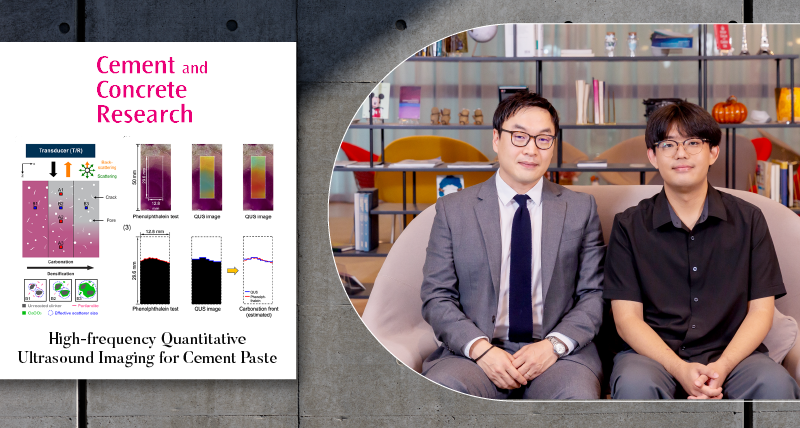A research team, led by Professor Gun Kim in the Department of Civil, Urban, Earth, and Environmental Engineering at UNIST, in collaboration with Professor Hyeong-Ki Kim from the Department of Architectural Engineering at Chosun University, and Professor Michael Oelze from the Department of Electrical and Computer Engineering at the University of Illinois at Urbana-Champaign, has introduced a revolutionary quantitative ultrasound (QUS) technology. This technology is capable of nondestructively measuring carbonation depth using high-frequency ultrasound signals (2.5 MHz). According to the research team, this marks the first time that the existing QUS method, generally used in a wide variety of clinical settings, has been successfully applied to the construction industry.
Concrete carbonation involves the capture of atmospheric CO2 and trapping it into concrete structures, making it a crucial technology for achieving carbon neutrality in the construction industry. Until now, measuring the microstructure changes associated with carbonation has relied on destructive methods due to the difficulty of assessing it using the existing nondestructive technique.
By analyzing ultrasonic scattering and attenuation characteristics of materials from collected ultrasonic signals and converting them into images, the research team succeeded in detecting microstructural changes, specifically the carbonation depth, with an error margin of only about 1 mm compared to results obtained through the phenolphthalein indicator method, a traditional destructive testing approach. This breakthrough demonstrates the feasibility of non-destructively measuring carbonation depth with pinpoint accuracy.
Typically, universal ultrasound imaging examinations require expert interpretation due to inherent resolution limitations. However, the developed technology utilizes quantitative indicators specific to the material to construct image pixels, enabling even inexperienced individuals to easily identify structural changes in materials.
Professor Kim Gun commented, “This study is groundbreaking in demonstrating the applicability of quantitative ultrasound imaging technology from the biomedical field to the construction sector.” He further stated, “The potential applications of this technology are vast, ranging from predicting the lifespan of automobile batteries to precise visualization of cancer tissues in future research endeavors.”
Their findings have been published in the online version of Cement and Concrete Research, a prestigious journal within the construction field on April 25, 2024. It has been supported by the National Research Foundation (NRF) of Korea grants, including the Emerging Research Projects and Basic Research Projects under the Ministry of Science and ICT.
Since joining the Department of Civil, Urban, Earth, and Environmental Engineering at UNIST in 2020, Professor Gun Kim has been conducting interdisciplinary research spanning construction engineering and polymer chemistry. Some of his notable research areas include leveraging focused ultrasonic energy for cancer tissue ablation, enhancing polymer molecular chain reinforcement, utilizing ultrasonic-based methods for structural integrity assessment, and designing stress visualization polymer sensors for simplified structure diagnostics.
Journal Reference
Seungo Baek, Hyeong-Ki Kim, Michael L. Oelze, and Gun Kim, “Can carbonation depth be measured in a nondestructive way? High-frequency quantitative ultrasound imaging for cement paste,” Cem. Concr. Res., (2024).












